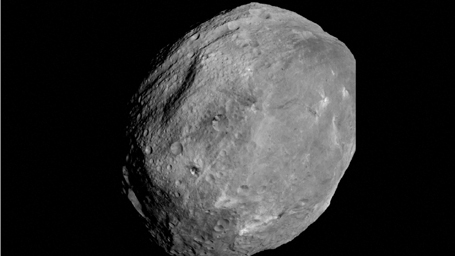
|
Vesta Full Rotation Movie
- Click the image above for a larger view
 Movie Download Options
Movie Download Options- Full-Res JPEG (1281 x 720) (75.3 kB)
- Full-Res TIFF (1281 x 720) (923.5 kB)
Caption:

Click on the image for the movie
In this movie, strung together from a series of images provided by the framing camera on NASA's Dawn spacecraft, we see a full rotation of Vesta, which occurs over the course of roughly five hours. These images were obtained on July 24, 2011, from a distance of about 3,200 miles (5,200 kilometers).
Background Info:
The Dawn mission to Vesta and Ceres is managed by NASA's Jet Propulsion Laboratory, Pasadena, Calif., for NASA's Science Mission Directorate, Washington, D.C. It is a project of the Discovery Program, managed by NASA's Marshall Space Flight Center, Huntsville, Ala. UCLA is responsible for overall Dawn mission science. Orbital Sciences Corporation of Dulles, Va., designed and built the Dawn spacecraft.
The framing cameras have been developed and built under the leadership of the Max Planck Institute for Solar System Research, Katlenburg-Lindau, Germany, with significant contributions by the German Aerospace Center (DLR) Institute of Planetary Research, Berlin; and in coordination with the Institute of Computer and Communication Network Engineering, Braunschweig. The framing camera project is funded by NASA, the Max Planck Society and DLR. More information about Dawn is online at http://www.nasa.gov/dawn .
Cataloging Keywords:
| Name | Value | Additional Values |
|---|---|---|
| Target | 4 Vesta | |
| System | Main Belt | |
| Target Type | Asteroid | |
| Mission | Dawn | |
| Instrument Host | Dawn | |
| Host Type | Orbiter | |
| Instrument | Framing Camera (FC) | |
| Detector | ||
| Extra Keywords | Grayscale, Movie, Rotation | |
| Acquisition Date | ||
| Release Date | 2011-08-01 | |
| Date in Caption | 2011-07-24 | |
| Image Credit | NASA/JPL-Caltech/UCLA/MPS/DLR/IDA | |
| Source | photojournal.jpl.nasa.gov/catalog/PIA14321 | |
| Identifier | PIA14321 | |
